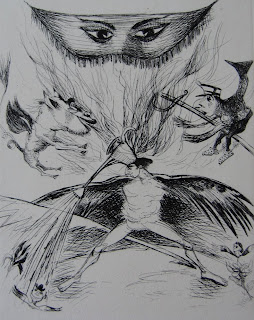Each etching is signed, justified and titled in pencil, but low down the sheet rather than directly below the image. The etchings are printed on Hollande van Gelder wove paper, presumably by the artist himself, as no printer is mentioned.
These etchings look beyond the modish self-regard of the Surrealists to locate the surreal in a long artistic tradition. There are touches in them of the grotesqueries of Hieronymous Bosch, the absurd animal/human hybrids of J.J. Grandville, even the fairy fantasies of Richard Doyle. But the artist they reference most is the one André Villeboeuf revered above all others: Francisco Goya. In 1799 Goya published a sequence of 80 etchings entitled Caprichos, which use elements of the supernatural and the surreal to satirize society's injustices. All 80 Caprichos can be seen here; they get weirder as the series progresses. André Villeboeuf didn't call his portfolio Caprices - he probably felt it would be ridiculously self-aggrandizing - but the debt to Goya is clear in this sequence of startling and unsettling visions. I'll let the images speak for themselves.
André Villeboeuf
Lubies no. 1: Canicule
Etching, 1934
André Villeboeuf
Lubies no. 2: Vol à voile
Etching, 1934
André Villeboeuf
Lubies no. 3: Cavalerie noire
Etching, 1934
André Villeboeuf
Lubies no. 4: Nuit de Chine
Etching, 1934
André Villeboeuf
Lubies no. 5: Torticolis
Etching, 1934
André Villeboeuf
Lubies no. 6: Idylle sous-marine
Etching, 1934
André Villeboeuf
Lubies no. 7: Gilles de Binche
Etching, 1934
André Villeboeuf
Lubies no. 8: Passion dévorante
Etching, 1934
André Villeboeuf
Lubies no. 9: Eloquence
Etching, 1934
André Villeboeuf
Lubies no. 10: Le retour du poilu
Etching, 1934
André Villeboeuf
Lubies no. 11: Comédie-française
Etching, 1934
André Villeboeuf
Lubies no. 12: Stratèges
Etching, 1934
André Villeboeuf
Lubies no. 13: La Mandragore
Etching, 1934
André Villeboeuf
Lubies no. 14: Général, la victoire vous sourit!
Etching, 1934
André Villeboeuf
Lubies no. 15: La Sainte-Hubert
Etching, 1934
André Villeboeuf
Lubies no. 16: Le coup de grâce
Etching, 1934


















What you say about "Los Caprichos" rings true. Perhaps it's not surprising that Andre Breton worked with neurological patients before his surrealist years. Once you see it, it's difficut not to find surrealism in things where you never noticed it before. Thanks for the whimsies.
ReplyDeleteJane - You're right about Breton - such a shame he became so dictatorial and self-righteous - the inspiration for surrealism was all there, combined with Freud of course. You're the Colette expert - weren't Villeboeuf and his wife friends of hers?
ReplyDeleteI had to dig for this, as I'm hardly an expert. In the 1920s, when Colette was married to Henri de Jouvenel, editor of Le Matin, they bought a home near Saint-Tropez - La Treille Muscate, and among the neighbors were several artists. (I wrote about that last year, actually, although I failed to mention the Villeboeufs.) Colette became friends with Suzanne Villeboeuf, and then with Andre. Colette often had warmer relationships with young women other than her own daughter, Colette de Jouvenal, nicknamed Bel Gazou.
ReplyDeleteThanks, Jane. I believe Suzanne was also an artist, though I've never seen any of her work.
ReplyDeleteAccording to the English translation of Colette's book "Break of Day" by Enid McLeod, Suzanne Villeboeuf was a painter.
ReplyDeleteNice blog and work
ReplyDeleteI just love your blog! You always have such interesting posts and pictures. I was fortunate enough to see a Dali exhibit at the Tate Museum back in 2000; that's when I fell in love with his sketches. Really like his work from the early stages of his career.
ReplyDeleteThanks, Jessica. I think you're right that Dali's early work is his best - by the end, he had degenerated into facile gimmickry (as the exhibits in the Dali Museum in Figueres demonstrate). Fascinating character, though.
ReplyDeleteI am afraid i am not a fan of Dali - instead, i would go anytime for what Villeboeuf does, for example... that idylle sous-marine ah!
ReplyDelete